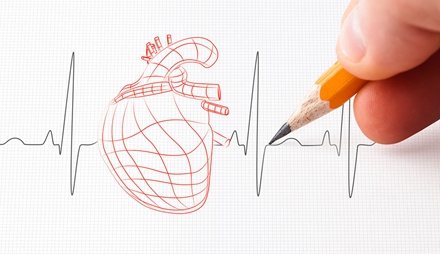If you take a good long listen to your heart,
大家如果聽一下自己的心跳
you'll actually notice that it makes sounds.
會發現其實心跳是有聲音的
And those sounds are usually described as lub dub, lub dub, lub dub.
心跳聲一般形容為“咚噠”、“咚噠”
And if you actually try to figure out what that would spell out like, usually it's something L- U- B, D- U- B.
寫出來的話形容一下這個聲音,就是咚-噠
And it just repeats over and over and over.
同樣的聲音不停地反復
And to sort of figure out where those sounds come from,
要弄清聲音的來源
what I did is I took that diagram of the heart that we've been using and actually exaggerated the valves,
我重新貼了心臟的圖著重畫了瓣膜的部分
made them really, really clear to see in this picture.
這樣大家看瓣膜看的很清楚了
And we'll use those valves to kind of talk through where those sounds are coming from.
我們利用這些瓣膜結構來看聲音是怎么產生的

So let's start by labeling our heart.
首先來標注一下心臟的結構
So we've got at the top, blood is coming into the right atrium and going to the right ventricle.
上邊,血液從右心房開始進入右心室
It goes off to the lungs, comes back into the left atrium and then the left ventricle.
然后進入肺部,流入左心房,再進入左心室
So these are the chambers of our heart.
這些是心臟內的房室
Now, keep your eye on the valves.
下面來看瓣膜
And we'll actually talk about them as the blood moves through.
順著血液流動我們來介紹
So let's start with blood going from the right atrium this way into the right ventricle.
從右心房這里開始流入右心室
Now, at the same moment that blood is actually going from the right atrium to the right ventricle,
同時,在血液從右心房流入右心室的時候
blood is actually also going from the left atrium to the left ventricle.
血液也在從左心房流入左心室
Now, you might think, well, how's that possible?
大家可能要問,這可能嗎?
How can blood be in two places at one time?
血液怎么可能同時在兩個地方?
But now remember that blood is constantly moving through the heart.
注意,血液一直是流動的
So in a previous cycle, you actually had some blood that was coming back from the lungs,
而上一個心臟工作周期中,可能有血液從肺部流出
and that's what's dumping into the left ventricle.
進入了左心房
And in a new cycle, you have a bit of blood that's going from the right atrium to the right ventricle.
而在這個工作周期中,血液也要從右心房進入右心室
So you have simultaneously two chambers that are full of blood-- the right and left ventricle.
這時就會存在兩個房室同時充滿血液,即右心室和左心室
Now, to get the blood into those ventricles, the valves had to open.
而血液要流入心室,瓣膜必須要打開
And specifically, let's label all the valves now.
為了確切起見,我們先來標注一下瓣膜名稱
So here you have our tricuspid valve, and I'm going to label that as just a T.
這里是三尖瓣,我們用T標注
And then up here, you have the pulmonary valve, and this'll be just a P.
這里是肺動脈瓣,我們用P標注
And on the other side, you've got the mitral valve, which separates the left atrium from the left ventricle.
這里是二尖瓣,二尖瓣把左心房和左心室分隔開
And you've got the aortic valve.
這里是主動脈瓣
So these are the four valves of the heart.
這就是心臟中的四個瓣膜結構
And as the blood is now in the ventricles,
現在血液都在心室中
you can see that the tricuspid and the mitral valve are open.
大家可以看到,三尖瓣和二尖瓣是打開的
So far, so good.
好,到現在的介紹大家應該能明白
Now, I've actually drawn the pulmonary valve as being open.
大家看到,我畫的肺動脈瓣也是打開的
But is that really the case?
不過這時確實是打開的嗎?
And the answer is no, because what happens
實際上,答案是否定的
is that as blood is moving down from the right atrium to the right ventricle, let's say that--
因為這時,血液從右心房進入右心室
and I'm going to draw it in black.
之后我用黑色畫
Black arrows represent the bad or the wrong direction of flow.
黑色的方向代表錯誤的血液流動方向
So let's say some blood is actually trying to go that way, which is not the way it should be going.
假設這時血液這樣流動,實際上這個方向是錯誤的
What happens is that these two valves, they, based on their shape,
那么根據瓣膜的構造
are actually not-- they're going to jam up.
這時瓣膜應該是堵塞的狀態
They're going to basically just jam up like this, and they're not going to let the blood pass through.
實際上是關閉的,瓣膜不會讓血液通過
So this is what happens as that valve closes down.
這是瓣膜關閉的情況











